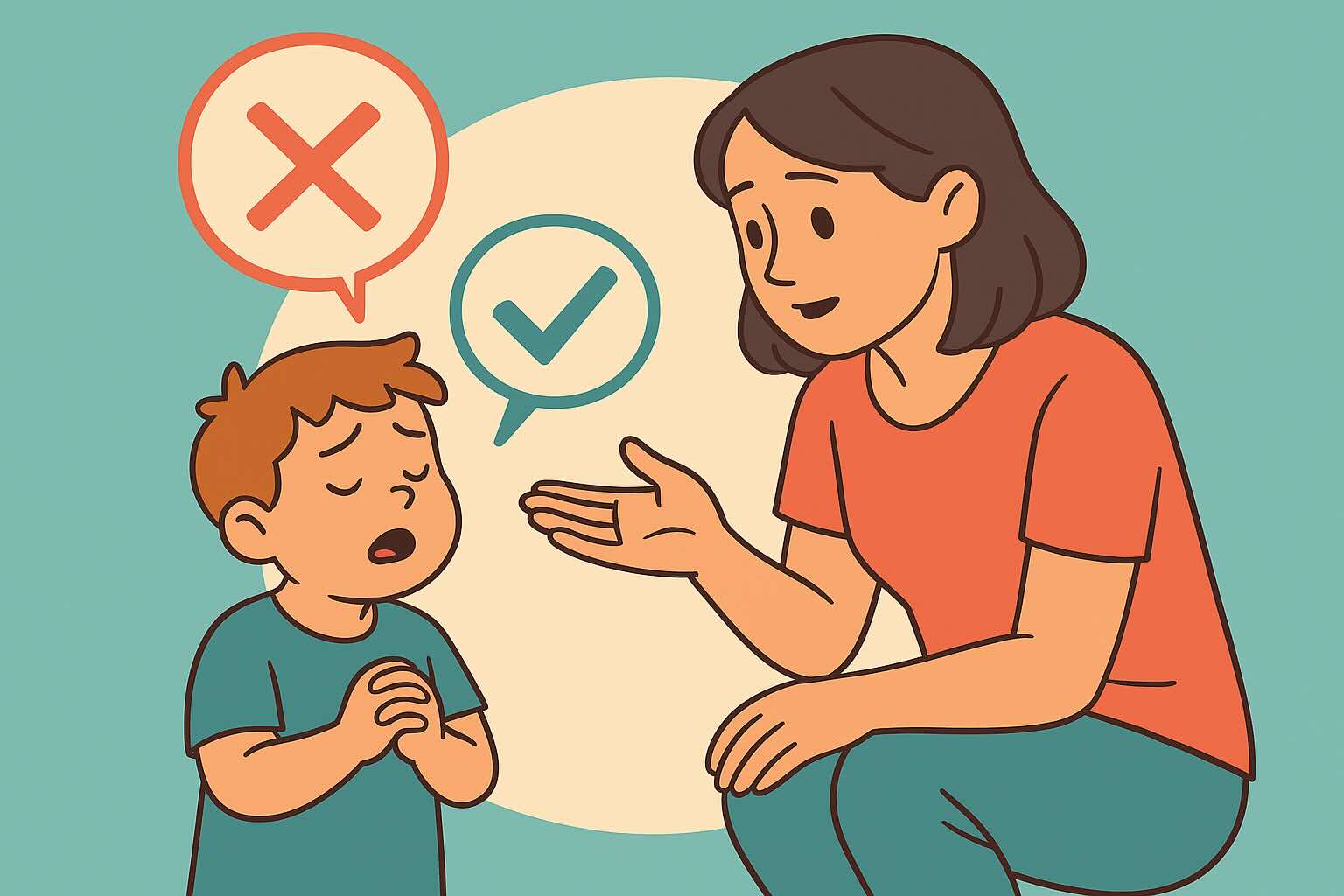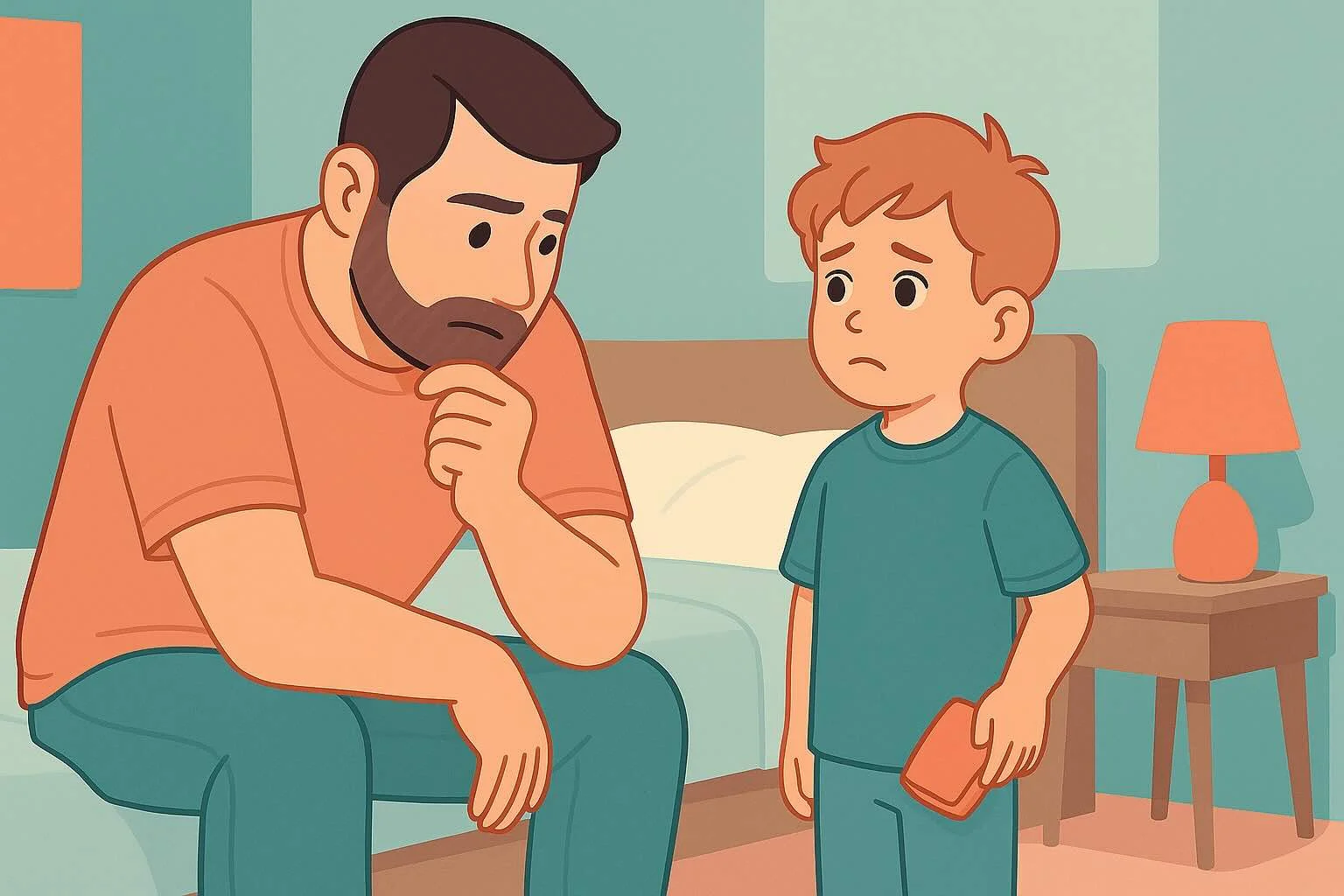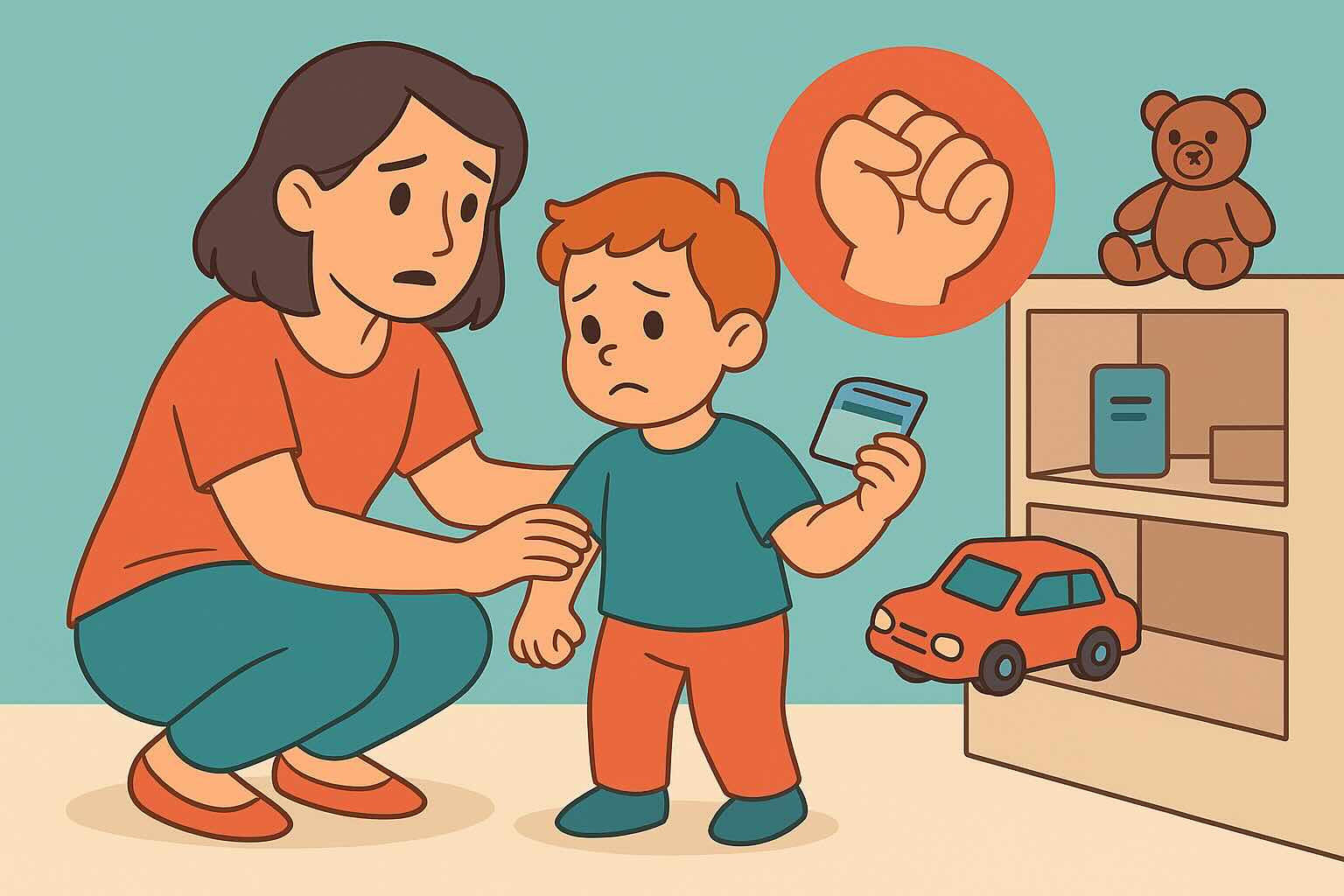How to Respond When Your Child Lies: 6 Trust-Building Scripts


The moment you realize your child has lied to you can trigger a flood of emotions: disappointment, anger, worry about their character, or panic about what this means for the future. But your response in these crucial moments determines whether lying becomes a pattern or an opportunity for growth and deeper connection.
This comprehensive guide provides you with word-for-word scripts and proven strategies for responding to lying in ways that build trust, encourage honesty, and strengthen your relationship. No more wondering what to say—you'll have practical tools that work in real-life situations.
For understanding why children lie in the first place, check out our complete guide to children's lying behavior, and for building trust, see our trust and honesty guide. Also explore our guides on imagination vs lying and addressing stealing behavior.
The Foundation: Your Mindset Matters More Than Your Words
Before You Say Anything: Check Your Internal State
Your child's response to lying depends heavily on your emotional state. Children can sense anger, disappointment, or panic, which triggers their defensive systems and makes honesty feel unsafe.
Take these steps first:
- Pause and breathe: Give yourself 10-15 seconds before responding
- Check your emotions: Notice if you feel angry, disappointed, or triggered
- Remember their age: Their lying reflects development, not defiance
- Recall your goal: Building trust and honest communication, not catching them
Helpful internal mantras:
- "This is a teaching moment, not a crisis"
- "My child is learning, not betraying me"
- "How I respond shapes their future honesty"
- "Connection before correction"
What NOT to Say (These Responses Increase Lying)
Avoid these common reactions that make children afraid to tell the truth:
❌ "Don't lie to me!" (Creates shame and defensiveness) ❌ "Why did you lie?" (Feels like an accusation, prompts defensive stories) ❌ "Liars don't get privileges!" (Makes lying about character, not behavior) ❌ "I can't trust you anymore!" (Damages relationship and self-esteem) ❌ "That's not true and you know it!" (Creates power struggles) ❌ "Good boys/girls don't lie!" (Implies they're bad for normal behavior)
These responses often lead to:
- More elaborate lies to avoid your reaction
- Children becoming better at hiding things
- Damaged parent-child trust and communication
- Increased shame and secrecy
The 3-Step Response Framework: What to Say Instead
Step 1: Validate the Emotion Behind the Lie
Your goal: Help your child feel understood, not judged, so they can be honest.
For task avoidance lies:
- ✅ "I think you really don't want to clean your room right now. I understand that feeling."
- ✅ "It sounds like brushing teeth feels hard tonight. Sometimes we don't feel like doing things."
- ✅ "I hear that you wish your homework was already done. That would be nice, wouldn't it?"
For getting-out-of-trouble lies:
- ✅ "I think you're worried about getting in trouble. That's a normal feeling."
- ✅ "I have a feeling you don't want me to be upset with you. I understand that."
- ✅ "It sounds like you wish this hadn't happened. Everyone feels that way sometimes."
For praise-seeking lies:
- ✅ "I think you want me to be proud of you. I love that you want to share good things with me."
- ✅ "It sounds like you want me to think you're amazing. You don't have to earn that—I already think you're wonderful."
- ✅ "I hear that you want some special attention from me. That's totally okay to want."
Step 2: Set Clear Boundaries About Truth-Telling
Your goal: Make it clear that honesty is important while maintaining emotional safety.
Gentle boundary setting:
- ✅ "It's okay to not want to do something AND I need you to tell me the truth about it."
- ✅ "I understand why you don't want to get in trouble AND we need to talk about what really happened."
- ✅ "I love how much you want me to be proud of you AND I'm proud of you for telling the truth."
For repeated lying:
- ✅ "We're working on being able to tell each other the truth, even when it's hard."
- ✅ "In our family, we practice honest communication. It's okay to make mistakes, and it's important to talk about them."
- ✅ "I want you to feel safe telling me anything, even when you think I might not like it."
Step 3: Guide Them Toward Truth and Problem-Solving
Your goal: Help them practice honesty and address the underlying issue.
Encouraging truth-telling:
- ✅ "When you're ready, you can tell me what really happened. I'm here to listen."
- ✅ "Let's figure out what's really going on so we can solve this together."
- ✅ "I think there's more to this story. Can you help me understand what really happened?"
Moving toward solutions:
- ✅ "Now that we know what really happened, let's think about what to do next."
- ✅ "Thank you for being honest with me. That helps us figure out how to handle this."
- ✅ "I appreciate you telling me the truth. Now let's work on [the actual problem]."
Situation-Specific Scripts: Exactly What to Say
Scenario 1: Task Avoidance Lies
Child says: "I already brushed my teeth." You know: They haven't brushed their teeth.
Ineffective response: "No, you didn't! I know you're lying. Go brush them right now!"
Effective response: "I think you wish you had already brushed your teeth because then you'd be done with that job. It's okay to not feel like doing something. Come on, let's go brush them together and maybe we can make it fun."
If they persist: "I hear that you really don't want to brush your teeth right now. Sometimes our brains tell us stories about things we wish were true. Let's go take care of your teeth, and then we'll be all set for bedtime."
Scenario 2: Getting Out of Trouble
Child says: "I didn't break the cup! It just fell by itself!" You know: You saw them knock it over while playing roughly.
Ineffective response: "I saw you do it! Stop lying to me! You're in big trouble now!"
Effective response: "I think you're worried about getting in trouble because the cup broke. I understand that feeling—nobody likes to get in trouble. Cups break sometimes when we're playing. Let's clean it up together and talk about being careful around breakable things."
If they elaborate the lie: "That's quite a story about how the cup broke. I think you really wish it wasn't your fault so you wouldn't have to feel bad about it. Everyone breaks things sometimes. What matters is that we clean up and learn from it."
Scenario 3: Praise-Seeking Lies
Child says: "I did my whole art project by myself! The teacher said it was the best one!" You know: You helped significantly, and the teacher praise seems exaggerated.
Ineffective response: "That's not true! I helped you with most of it, and I doubt the teacher said that!"
Effective response: "You worked really hard on that project, and I enjoyed helping you with it. It sounds like you want me to be proud of you. I'm always proud of how much effort you put into things. What part of the project did you feel best about?"
If they insist: "I can see how much you want me to think you're amazing at art. Here's what I want you to know: I think you're amazing whether your project is perfect or not, whether you do it alone or with help. What made you feel good about working on it?"
Scenario 4: Elaborate Fantasy Explanations
Child says: "A big kid took my lunch money and threw it in the garbage, and then the garbage truck came and took it away, and that's why I don't have it." You suspect: They spent it on something else or lost it.
Ineffective response: "That's ridiculous! That didn't happen! Tell me the truth right now!"
Effective response: "That would be really upsetting if all those things happened. I think you might be worried about telling me what really happened to your lunch money. I'm not going to be angry. Let's figure out together what actually happened so we can solve the problem."
For persistent elaborate stories: "You have such a creative imagination! That story has lots of details. I think you might be telling me this story because you don't want to get in trouble about the lunch money. It's okay to make mistakes with money. Can you help me understand what really happened?"
Advanced Strategies for Challenging Situations
When Your Child Won't Give Up the Lie
Don't engage in arguments or trying to prove they're lying:
❌ "I know you're lying!" ❌ "Yes, you did!" / "No, I didn't!" battles ❌ Presenting evidence to force confession
Instead, acknowledge their persistence while maintaining reality:
✅ "I can see you really don't want this to be your fault. That's understandable." ✅ "You're sticking to your story, and I think that's because you're worried about what happens next." ✅ "I notice you really want me to believe this version. I think you're trying to protect yourself from feeling bad."
Then redirect to the underlying emotion:
"Let's take a break from figuring out exactly what happened and talk about how you're feeling right now. What are you worried about?"
When Lying Becomes a Pattern
Have reflective conversations during calm moments:
"I've noticed that when you think you might get in trouble, you sometimes tell me stories that aren't quite true. I think this happens because you don't want me to be upset with you. Can we talk about this?"
Explore underlying needs:
- "What makes it hard to tell me when something goes wrong?"
- "What do you think would happen if you told me about a mistake?"
- "How can I help you feel safer telling me difficult things?"
Create family agreements:
- "In our family, we're going to practice being honest, even when it's hard."
- "Let's work together on making it feel safe to tell the truth."
- "We all make mistakes, and we can talk about them without anyone being in huge trouble."
When Safety Is Involved
For situations involving safety or potential harm:
"I need to know what really happened so I can keep you safe. I'm not asking because I want to get you in trouble. I'm asking because your safety is the most important thing to me."
If they continue to lie about safety issues:
"Right now, keeping you safe is more important than anything else. We can talk about everything else later, but I need the truth about this one thing right now."
Building Long-Term Honest Communication
Create Daily Opportunities for Truth-Telling
Regular check-ins that normalize sharing difficulties:
- "What was something tricky about your day?"
- "Did anything happen today that you weren't sure how to handle?"
- "Was there anything you wished had gone differently?"
Celebrate honesty, especially when it's difficult:
- "Thank you for telling me about that, even though you thought I might be upset."
- "I really appreciate your honesty. That took courage."
- "It helps our family when we can talk about difficult things together."
Model Honest Communication Yourself
Share age-appropriate examples of your own mistakes:
- "I made a mistake at work today and had to tell my boss about it. It felt uncomfortable, but it was the right thing to do."
- "I accidentally broke Mom's favorite mug this morning. I was worried she'd be upset, but I told her right away."
Be honest about your emotions:
- "I felt frustrated when I found out you hadn't cleaned your room, but I'm glad we can talk about it."
- "It makes me happy when you tell me the truth, even about mistakes."
Use Family Conversations to Normalize Difficult Topics
Regular family discussions about emotions and mistakes:
- "Let's each share one mistake we made this week and one thing we learned from it."
- "Has anyone felt worried about telling the truth about something?"
- "What makes it easier or harder to be honest in our family?"
Create family mottos around honesty:
- "In our family, mistakes are for learning, not for hiding."
- "We tell the truth because we care about each other."
- "Honesty helps us solve problems together."
Your 30-Day Action Plan for Better Responses
Week 1: Master Your Own Reactions
- Practice the pause before responding to any lie
- Focus only on staying calm and validating emotions
- Don't worry about perfect responses—just avoid the harmful ones
- Notice your triggers and work on managing them
Week 2: Implement the 3-Step Framework
- Use validation, boundaries, and guidance in every lying situation
- Keep responses short and focused
- Practice the specific scripts provided above
- Celebrate small improvements in your responses
Week 3: Address Patterns and Build Trust
- Have reflective conversations about lying during calm moments
- Start family discussions about emotions and mistakes
- Begin modeling your own honesty more explicitly
- Create regular check-in opportunities
Week 4: Strengthen Long-Term Communication
- Establish family practices around honest communication
- Celebrate your child's honesty consistently
- Continue refining your responses based on what works
- Plan for ongoing growth and connection
When to Seek Additional Support
Consider Professional Help If:
- Lying increases despite consistent, patient responses over 2-3 months
- Child shows no guilt or remorse about lying
- Lies become more elaborate and compulsive over time
- Lying is accompanied by other concerning behaviors
- Family relationships are significantly strained by lying patterns
- You feel overwhelmed and unable to respond calmly
Types of Support Available:
Family therapists can help improve communication patterns and family dynamics Child psychologists specialize in understanding underlying emotional needs Parent coaches provide practical strategies and support for implementation Pediatricians can rule out developmental or medical factors
Key Takeaways: Responding to Lying Effectively
- ✅ Your emotional state matters more than perfect words—stay calm first
- ✅ Validate the emotion behind the lie before addressing the behavior
- ✅ Avoid "why" questions and accusations that trigger defensiveness
- ✅ Use the 3-step framework: validate, set boundaries, guide toward truth
- ✅ Don't argue or try to prove they're lying—focus on underlying needs
- ✅ Create safety for truth-telling through your consistent responses
- ✅ Celebrate honesty especially when it's difficult for them
- ✅ Address patterns through reflective conversations during calm moments
- ✅ Model honest communication in your own daily interactions
- ✅ Seek support if lying becomes compulsive or concerning
Remember: Every time you respond to lying with understanding and guidance rather than anger and punishment, you're building a foundation for lifelong honest communication with your child.
This article provides general guidance based on child development principles. Every child and family situation is unique. Trust your instincts and seek professional support if you have ongoing concerns about your child's honesty or your family communication patterns.
24/7 AI Parenting Assistant
Get instant, personalized advice with expert-curated parenting knowledge. Chat with your AI coach anytime, anywhere.

Trust Building Toolkit
Daily practices and scripts to build unshakeable trust and honest communication with your child.
Frequently Asked Questions
Need personalized support?
RootWise's AI coach can provide tailored strategies for your specific situation, available 24/7 when you need it most.
Learn More About AI Coaching →



